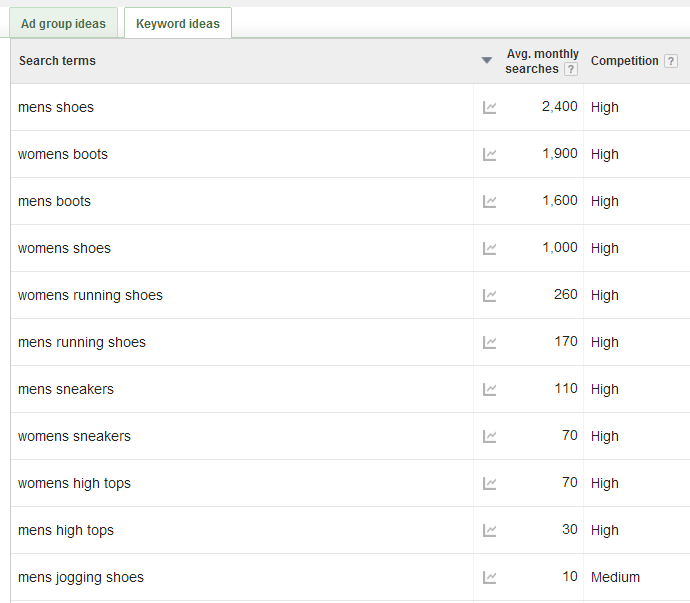Google keyword research is the foundation of any successful paid campaign. Choosing the most accurate keywords to bid on, that will generate the most clicks and conversions is a step that you want to properly invest in. Using the wrong keywords will likely end up serving your ads to the wrong audience. And what’s the point of an ad if it doesn’t reach those who want to click on it?
It’s all about understanding your customers and predicting which terms they would type in the search box. But it doesn’t mean you have to do any guesswork. In this guide, you’ll learn how to create, refine, and organize your Google keyword list, to make your campaigns better targeted and more effective.
Step One: Initial brainstorming
The starting point for Google keyword research is to simply brainstorm a keyword list. Scan your website, blog and most importantly the landing pages your ads will be linking to, and gather relevant keywords from the text. This should provide you with enough material to put together a comprehensive keyword list that relates to your products or services.
Another important thing to remember is to simply put yourself in the customer’s shoes. What kind of words or queries would you use if you were looking for a service/product like yours?
All keywords fall under one of four categories:
- Branded Terms – keywords that contain your brand name and any trademarked terms such as slogans and taglines.
- Product/Service Terms – terms that relate to the products or services you offer.
- Related Terms – words that don’t directly relate to your products and services, but that users who are interested in what you’re selling may be searching for.
- Competitor Terms – The brand names of your competitors and their trademarked terms. According to Google guidelines, you can’t use your competitors trademarked terms in your ad copy and could be sued for doing so. You can, however, bid on these phrases and use them in your website and landing page copy.
1.2 Include variations and synonyms
Search engines can sometimes make connections between related terms, like apartment and flat for example. But it’s far from being a foolproof system, so your best bet is to include all possible variations, synonyms, abbreviations, and even plurals.
Let’s take the term ‘women’s sneakers’, for example. Here are a few alternatives:
Women’s sneakers
Women’s trainers
Ladies sneakers
Women’s running shoes
Women’s gym shoes
Keep in mind typing that spelling mistakes happen all the time, so it can be a good idea to include misspelled words (Business, Buisness, busines) and alternative spellings (Hannukah, Chanukah, Hannuka). An important word of warning: If you include misspelled words in an ad group when you’re using Dynamic Keyword Insertion in your ad copy, the misspelled words will appear in your ad. To avoid looking unprofessional, create a separate group for misspellings.

1.3 Get specific
Start with broad keywords, and get more and more specific. Including broad or “overarching” terms in a campaign has its benefits – general terms such as “shoes” have a higher search volume. However, long-tail keywords with higher specificity are more likely to hit user search intent.
‘Shoes’ could mean women’s shoes, men’s shoes, kids’ shoes, heels, boots, and the list goes on. A very specific, long-tail keyword phrase like “women’s knee-high black boots” might get few searches per month, but the user will be much more likely to click on your ad because it’s exactly what they are looking for.
Moreover, the more specific a term, the less competitive it is. This means that fewer companies are bidding on it, which allows for lower bids.
1.4 Consider voice search
Voice-based searches are consistently on the rise in recent years. As a result, search engines are increasingly able to understand longer strings of words, that reflect how people actually speak. Instead of “Japanese restaurants San Francisco”, someone using voice search would say “what’s the best Japanese restaurant in San Francisco” or “where can I get Japanese food in San Francisco?”
Take that into account and don’t shy away from including variations such s “How do I…?”, “Where is the…?” “What is the…?” etc.
Step Two: Refine Your List with a Keyword Research Tool
When you finally have a substantial list of potential keywords, it’s time to refine it with the help of a keyword research tool. It will help you zero in on the terms people actually search for, and make an informed decision on which words to keep and which ones to drop. Research tools will also reveal which keywords your competitors are ranking for and help you discover new terms that you hadn’t thought of.
Each keyword tool is a little different, but the core function is the same. They provide insight into a keyword’s monthly search volume and competition rank. The higher a word’s competition rating, the more advertisers are bidding on that word, which means that you’ll have to pay more to have your ad appear in the top positions.
Ideally, you’ll be able to find a few words that have a good balance of high search volume, low competition, and low cost. Those words can drive considerable traffic without costing a fortune.
That being said, don’t only aim for low-cost. Some costly words could be worth it because they generate a high conversion rate or target customers who can afford more expensive products or services. These are all things to take into consideration when you start cutting words out of your list.

There are dozens of free and paid tools out there. Some of our favorites include:
- Google Keyword Planner (included inside Google Ads) – Free
- Ahrefs
- Ubersuggest
- WordStream Keyword Tool
- SpyFu
- Semrush
Step Three: Sort Your Keywords Into Groups
The next step after refining your keyword list is to sort it into small, targeted groups of keywords that are closely related to each other. These groupings will correspond with your ad groups in Google Ads.
For example, let’s say you’re running a campaign to promote a new couch. You put together a list of ten keywords to target people looking to buy a new couch and create three ads – that’s an ad group. Your keywords should be grouped together based on search intent.
Don’t underestimate the importance of this step. Small, well-organized ad groups will considerably benefit any account. The tighter and more focused your ad groups are, the easier it will be to measure the performance of each keyword and create highly specific and targeted ads. High-relevance ads attract high-relevance leads. And that causes your Quality Score to improve. You want your PPC campaigns to have the best possible Quality Score – it helps your ads rank higher and reduces the amount you have to pay for each click and each conversion.

Step Four: Add Negative Keywords
As important as it is to figure out which keywords you want to target, it’s equally critical to know what words you don’t want to target. Negative keywords are the search terms you don’t want your ads to show up for.
Including negative keywords is important because they prevent your ads from showing up for queries that are irrelevant or offensive. For example, if you’re selling artificial Christmas trees you don’t want clicks from people looking for real Christmas trees. So you need to add “real Christmas trees” and “fresh Christmas trees” to your negative keyword list. Or, say you’re advertising shade solutions. In that case, you would target plenty of keywords containing the word “shade” – but you wouldn’t want to target a keyword like “lampshade”, because it’s not what you sell. So “lamp” should be one of your negative keywords.
The match type you assign to your negative keyword has a huge impact on the kind of traffic it blocks. Match types – both regular and negative – are a broad subject in and of themselves. Generally speaking, broad match negatives are used to disqualify any query that contains your negative term, such as ‘lamp’. Phrase and exact match disqualify more specific queries that contain long-tail negative keywords.
It’s best to research and set negative keywords before your campaign goes live, but don’t stop there. A good tip for discovering negative keywords for your campaign is to take a look at your query reports and see what searchers are looking for when Google serves your ad. If you find words in the search query reports that don’t fit your account, set them as negative.
Final Thoughts
Google keyword research might be the most important part of the strategy for search ads, so take the time to get it right. Wordstream recommends spending about 15% of your PPC management time on keyword research.
Note that it is an ongoing effort. You’re not going to discover every single keyword you should bid on or exclude in the first round. Follow the steps above and continue optimizing your account by adding new keywords, setting new negatives, and experimenting with new match types. Your account will only get more focused, accurate, and effective over time.



